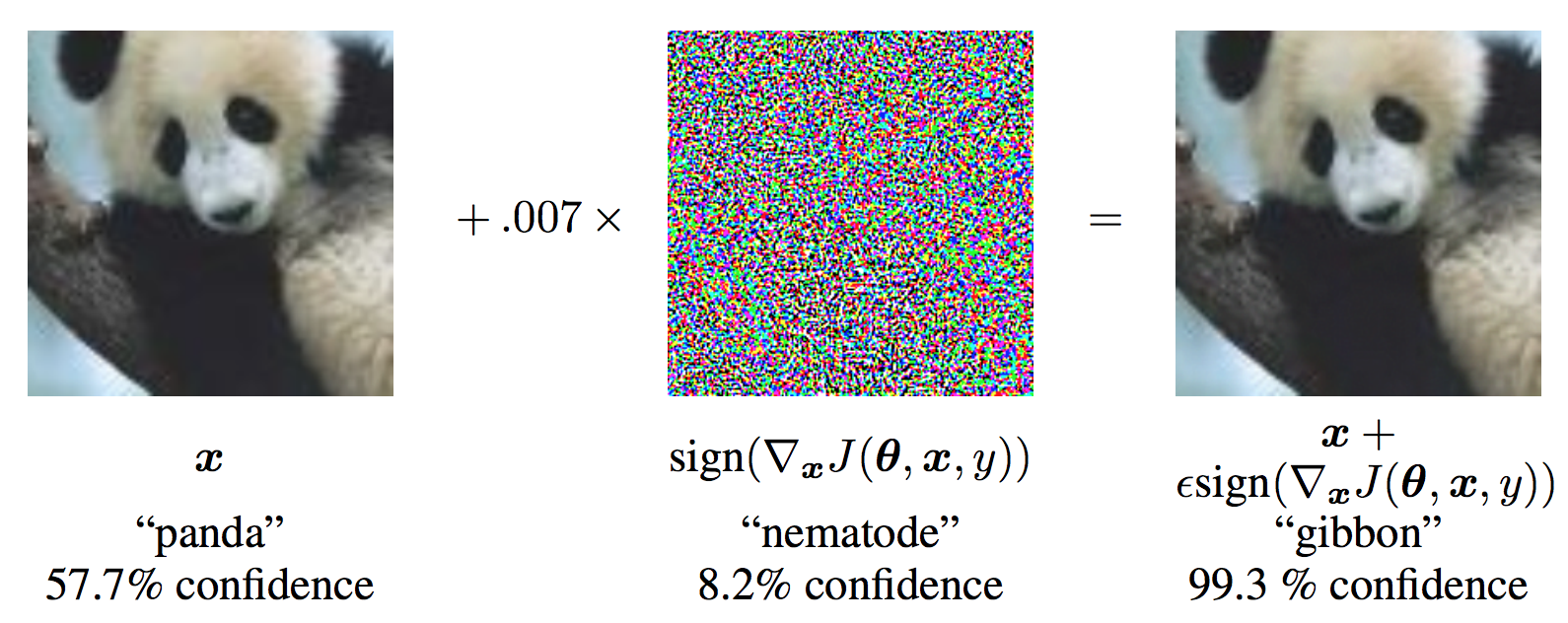最著名的对抗样本算法应该就是 *Fast Gradient Sign Attack(*FGSM)快速梯度算法,其原理是,在白盒环境下,通过求出模型对输入数据的导数,用****函数求得其梯度方向,再乘以步长,得到的就是其扰动量,将这个扰动量加在原来的输入上,就得到了在FGSM攻击下的样本,这个样本很大概率上可以使模型分类错误,这样就达到了攻击的目的。
我们令原始的输入为x,输出为y。则FGSM的攻击表达式为:
 (1)
(1)
由公式1可知,FGSM实质上就是一种梯度上升算法,通过细微地改变输入,到达输出的预测值与实际值相差很大的目的。
假设x的维度为n,模型参数在每个维度的平均值为m,的无穷范数为,每个维度的微小修改与梯度函数方向一致(个人觉得可以理解为梯度上升),则累积的改变量就是。例如,一张[16,16,3]的图片,则维度为768,通常很小,我们取0.01,m取1,那么累计的扰动就是7.68。
关于FGSM的实现主要参考对抗样本pytorch官网加上自己的理解,安装好pytorch后,下载好预训练的模型,提取码:dcr6,可直接运行。:
from __future__ import print_function
import torch
import torch.nn as nn
import torch.nn.functional as F
import torch.optim as optim
from torchvision import datasets, transforms
import numpy as np
import matplotlib.pyplot as plt
from matplotlib.ticker import FuncFormatter
plt.rcParams['font.sans-serif'] = ['SimHei']
plt.rcParams['axes.unicode_minus'] = False
# 这里的扰动量先设定为几个值,后面可视化展示不同的扰动量影响以及成像效果
epsilons = [0, .05, .1, .15, .2, .25, .3,.35,.4]
# 这个预训练的模型需要提前下载,下载链接如上
pretrained_model = "data/lenet_mnist_model.pth"
use_cuda=True
# 就是一个简单的模型结构
class Net(nn.Module):
def __init__(self):
super(Net, self).__init__()
self.conv1 = nn.Conv2d(1, 10, kernel_size=5)
self.conv2 = nn.Conv2d(10, 20, kernel_size=5)
self.conv2_drop = nn.Dropout2d()
self.fc1 = nn.Linear(320, 50)
self.fc2 = nn.Linear(50, 10)
def forward(self, x):
x = F.relu(F.max_pool2d(self.conv1(x), 2))
x = F.relu(F.max_pool2d(self.conv2_drop(self.conv2(x)), 2))
x = x.view(-1, 320)
x = F.relu(self.fc1(x))
x = F.dropout(x, training=self.training)
x = self.fc2(x)
return F.log_softmax(x, dim=1)
# 运行需要稍等,这里表示下载并加载数据集
test_loader = torch.utils.data.DataLoader(
datasets.MNIST('../data', train=False, download=True, transform=transforms.Compose([
transforms.ToTensor(),
])),
batch_size=1, shuffle=True)
# 看看我们有没有配置GPU,没有就是使用cpu
print("CUDA Available: ",torch.cuda.is_available())
device = torch.device("cuda" if (use_cuda and torch.cuda.is_available()) else "cpu")
# 初始化网络
model = Net().to(device)
# 加载前面的预训练模型
model.load_state_dict(torch.load(pretrained_model, map_location='cpu'))
# 设置为验证模式.
model.eval()
接着实现FGSM的功能
# FGSM attack code
def fgsm_attack(image, epsilon, data_grad):
# 使用sign(符号)函数,将对x求了偏导的梯度进行符号化
sign_data_grad = data_grad.sign()
# 通过epsilon生成对抗样本
perturbed_image = image + epsilon*sign_data_grad
# 做一个剪裁的工作,将torch.clamp内部大于1的数值变为1,小于0的数值等于0,防止image越界
perturbed_image = torch.clamp(perturbed_image, 0, 1)
# 返回对抗样本
return perturbed_image
对测试集进行预测以及对比测试集标签
def test( model, device, test_loader, epsilon ):
# 准确度计数器
correct = 0
# 对抗样本
adv_examples = []
# 循环所有测试集
for data, target in test_loader:
# 将数据和标签发送到设备
data, target = data.to(device), target.to(device)
# 设置张量的requires_grad属性。重要的攻击
data.requires_grad = True
# 通过模型向前传递数据
output = model(data)
init_pred = output.max(1, keepdim=True)[1] # 得到最大对数概率的索引
# 如果最初的预测是错误的,不要再攻击了,继续下一个目标的对抗训练
if init_pred.item() != target.item():
continue
# 计算损失
loss = F.nll_loss(output, target)
# 使所有现有的梯度归零
model.zero_grad()
# 计算模型的后向梯度
loss.backward()
# 收集datagrad
data_grad = data.grad.data
# 调用FGSM攻击
perturbed_data = fgsm_attack(data, epsilon, data_grad)
# 对受扰动的图像进行重新分类
output = model(perturbed_data)
# 检查是否成功
final_pred = output.max(1, keepdim=True)[1] # 得到最大对数概率的索引
if final_pred.item() == target.item():
correct += 1
# 这里都是为后面的可视化做准备
if (epsilon == 0) and (len(adv_examples) < 5):
adv_ex = perturbed_data.squeeze().detach().cpu().numpy()
adv_examples.append( (init_pred.item(), final_pred.item(), adv_ex) )
else:
# 这里都是为后面的可视化做准备
if len(adv_examples) < 5:
adv_ex = perturbed_data.squeeze().detach().cpu().numpy()
adv_examples.append( (init_pred.item(), final_pred.item(), adv_ex) )
# 计算最终精度
final_acc = correct/float(len(test_loader))
print("扰动量: {}\tTest Accuracy = {} / {} = {}".format(epsilon, correct, len(test_loader), final_acc))
# 返回准确性和对抗性示例
return final_acc, adv_examples
画出随着扰动量变化,准确率变化的曲线。
accuracies = []
examples = []
# 对每个干扰程度进行测试
for eps in epsilons:
acc, ex = test(model, device, test_loader, eps)
accuracies.append(acc*100)
examples.append(ex)
plt.figure(figsize=(5,5))
plt.plot(epsilons, accuracies, "*-")
plt.yticks(np.arange(0, 110, step=10))
plt.xticks(np.arange(0, .5, step=0.05))
def to_percent(temp, position):
return '%1.0f'%(temp) + '%'
plt.gca().yaxis.set_major_formatter(FuncFormatter(to_percent))
plt.title("准确率 vs 扰动量")
plt.xlabel("扰动量")
plt.ylabel("准确率")
plt.show()
扰动量: 0 Test Accuracy = 9810 / 10000 = 0.981 扰动量: 0.05 Test Accuracy = 9427 / 10000 = 0.9427 扰动量: 0.1 Test Accuracy = 8510 / 10000 = 0.851 扰动量: 0.15 Test Accuracy = 6826 / 10000 = 0.6826 扰动量: 0.2 Test Accuracy = 4299 / 10000 = 0.4299 扰动量: 0.25 Test Accuracy = 2084 / 10000 = 0.2084 扰动量: 0.3 Test Accuracy = 872 / 10000 = 0.0872 扰动量: 0.35 Test Accuracy = 352 / 10000 = 0.0352 扰动量: 0.4 Test Accuracy = 167 / 10000 = 0.0167
通过上图我们可以看到随着扰动量的增加,模型预测的准确度越来越低,当增加到0.4的扰动量时,模型预测错误率已经达到了98.33%
以下代码显示通过对抗后,模型预测的结果以及增加扰动量后的图像成象样式:
# 在每个处绘制几个对抗性样本的例子
cnt = 0
plt.figure(figsize=(8,10))
for i in range(len(epsilons)):
for j in range(len(examples[i])):
cnt += 1
plt.subplot(len(epsilons),len(examples[0]),cnt)
plt.xticks([], [])
plt.yticks([], [])
if j == 0:
plt.ylabel("扰动: {}".format(epsilons[i]), fontsize=14)
orig,adv,ex = examples[i][j]
plt.title("{} -> {}".format(orig, adv))
plt.imshow(ex, cmap="gray")
plt.tight_layout()
plt.show()
需要注意的是,A——>B,其中A为实际值,B为预测值。随着模型扰动量的增加,预测值也越来越离谱。与此同时,随着扰动量的增加,我们可以看到模型也变得越来越模糊。由于本实验是对黑白图片数字进行识别,其所具有的特征点(即维度)相对比较少,因此想要使模型预测错误率很高,扰动量也必须加到很大。如果是复杂度较高的图片,只需要增加一点扰动量便可以,使错误率增加的很大。例如,经典熊猫图,由于其图片复杂度较高,因此只需要添加0.007的扰动量,便可以使预测错误率达到99.3%。

版权归原作者 小二的安全指北 所有, 如有侵权,请联系我们删除。

